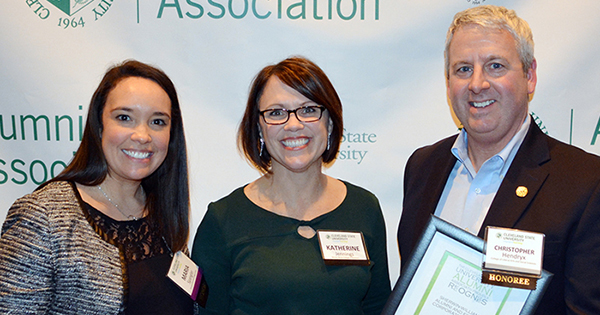The Dollars (and Sense) of Higher Education
 CSU Innovations Help Speed Time to Graduation
CSU Innovations Help Speed Time to Graduation
When Cleveland State University sophomore Donnetta Monk earns her degree in a couple of years, she’ll have a lot of options. Perhaps she’ll go directly into law school, as is her current plan, and prepare for a career in immigration law. Or, maybe she’ll pursue another passion first and head abroad to teach English.
It’s even possible that Donnetta will decide on a path, post-CSU, that she hasn’t considered yet. However, regardless of her first move out of college, she will be on track to achieve something very significant just by virtue of completing her undergraduate degree – higher annual wages and better overall lifetime earnings than would have been possible for her as a high school graduate.
A college education has always significantly improved the prospects of those who attain it, and its importance is becoming even greater with massive changes occurring in the economy. According to the Ohio Department of Education, nearly two-thirds (64 percent) of all jobs in the state will require a postsecondary degree or credential by 2020.
Unfortunately, the number of Ohio students who continue their education past high school is extremely low. Ohio sits in the bottom third of all states in higher education attainment, according to a September 2016 report from the Higher Education Compact of Greater Cleveland, an organization that brings together community groups, educational institutions and other local stakeholders to work toward getting more Clevelanders into and through college.
Just 37 percent of Ohioans in 2014 had any kind of postsecondary degree (associate’s or higher), according to the report.
If you look at the numbers for students of color in Ohio, the situation is even more dire. Only one-quarter of African Americans had a college degree in 2014, and Hispanics fared even worse, with just 24 percent having a degree of associate’s or higher.
Cost Keeps Students Away
One of the biggest barriers Ohio students face when considering higher education is cost.
The main need-based source of funding for students, federally, is the Pell Grant, which has become more restrictive. Less money is available than in years past, and students may now only use Pell Grants in fall and spring. If students need to take summer classes to stay on track, they must either pay out of pocket or take out a loan to pay back later.
“Most states have a program that supplements federal financial aid programs. We have a program called OCOG (the Ohio College Opportunity Grant), but that program has been dramatically cut and provides very limited need-based support to students,” says President Ronald M. Berkman.
“Alumni are often bewildered when they hear all the stories about student debt,” says Brian Breittholz, assistant vice president for alumni relations. “They recall how they worked to put themselves through school and wonder why current students don’t do the same, when in reality, today’s students often work multiple jobs to cover educational expenses.”
Often, students need federal aid even while working, and it’s not uncommon for students to ‘max out’ on that aid before finishing their degree, leaving many thousands of Ohio students to plug funding gaps with student loans.
According to Philanthropy Ohio, 66 percent of Ohio students take out loans to pay for college. Their average debt load by graduation is more than $30,000, the 10th largest in the nation, although the average debt of a CSU student at graduation is about 9 percent lower than that statewide figure, at less than $28,000.
Time is Money
According to President Berkman, there is one way, above all others, for students to keep their college costs down, and that is to finish their degree in four years. That’s not only because of more stringent rules regarding financial aid; it’s a simple matter of arithmetic.
Here’s how he breaks down the financial benefit of an on-time graduation. (These numbers are approximate, and based on the University’s annual cost of attendance of about $26,000, a figure that captures not only tuition, but all of the costs associated with attending CSU):
“If students do two additional years, that is six rather than four, they have already spent another $52,000. If you add to that the wages they may have lost by being out of the labor market for two years, and let’s be conservative and say that’s $25,000 per year, that’s already around $100,000 in cost. And if you add to that the interest that they might have to pay on the additional loans they would have needed for those two additional years, the negative financial impact is even greater.”
Given the challenges students face with graduating on time, though, this clear answer is not as easy as it sounds.
Student Success Focus Pays Dividends
At CSU, a set of nationally recognized success initiatives has been put into place over the past several years aimed at helping students get from their first semester to graduation as quickly as possible and with the least amount of debt.
One of the most significant changes is the implementation of multi-term registration, says President Berkman.
“This had never been done before. Students would typically register one semester at a time, and they had no knowledge of what was going to be available from semester to semester. Now, they can register for three semesters at a time — fall, spring and summer. And when they register for those, they are guaranteed those courses,” he says. This helps ensure that students can take the courses they need, exactly when they need to take them.
Added to multi-term registration is the implementation of demand-driven enrollment, where students can be put on wait lists if the classes they need are full, and when enough students get on a wait list, the University creates a new section to accommodate them.
To further keep students on track, the degree audit digital tool allows students to monitor the requirements of their programs of study to make sure they are taking the correct courses and meeting their requisites and pre-requisites.
Critical Financial Support and Incentives Have Also Been Put in Place
To further encourage students to take the kinds of course loads most likely to get them to graduation on time, students can take up to 18 credits per semester and pay the same amount as those who take 12 credits. Taking more credits per semester can certainly help students finish on time; for some, it could even mean an early graduation, which further lowers the cost of attendance.
On the financial assistance side are the institutional scholarships that CSU provides to high achieving students.
“Let’s just take the Presidential Scholarship, which is $6,000 a year, eligible for four years. That’s $24,000 that is available to students for their educational costs. And what we see is that 88 percent of these students are successful and continue from year to year,” says Cindy Skaruppa, vice president for enrollment services.
 Still, even with scholarships, many students start running out of money as they near graduation, and for them, the Radiance Scholarship was instituted in 2011. Funded solely by private support, Radiance provides “last dollars” for students who need a bit more support to get over the finish line. Over the past six years, more than $6.7 million has been raised and more than 1,520 Radiance Scholarships have been awarded.
Still, even with scholarships, many students start running out of money as they near graduation, and for them, the Radiance Scholarship was instituted in 2011. Funded solely by private support, Radiance provides “last dollars” for students who need a bit more support to get over the finish line. Over the past six years, more than $6.7 million has been raised and more than 1,520 Radiance Scholarships have been awarded.
Just last year, an additional scholarship, called The Last Mile, was introduced for students who are within one or two semesters of graduating.
In addition, two years ago, CSU launched ENGAGE: The Campaign for Cleveland State University with the goal of raising $100 million to support scholarships and student success. This funding has been critical to CSU’s efforts to help students graduate on time.
Of course, more can still be done. New initiatives under development include support for students transferring from community college and for those who are experiencing crises that threaten their ability to continue their studies.
“The bottom line — CSU is determined to help students succeed and graduate with as little debt as possible. We’ve dedicated ourselves to helping students save time and money while earning degrees that prepare them for career success. In turn, we’ve seen dramatic increases in retention and graduation rates,” notes President Berkman.
“Our efforts to improve affordability and degree attainment will help ensure a larger pool of qualified graduates to meet the state’s future workforce needs. That’s good news for Ohio”
The Future: Ours to Secure
For all of Cleveland State’s efforts, however, Ohio will not be able to fully meet the needs of the changing economy without greater state support for higher education.
“State support of higher education isn’t a handout, it’s an investment in Ohio’s future,” says Breittholz. “Economic impact studies repeatedly show how every dollar invested in education has a multiplier effect on everything from jobs created to taxes paid to an increase in research dollars, patents and discoveries garnered.”
Adds President Berkman, “Funding for higher education and closing the talent gap must become priorities for Ohio. State investment is critical if Ohio is to provide the educated workforce to attract new employers.
“Higher education funding is imperative to continuing the momentum generated by the innovative efforts of our universities, while also keeping pace with the investments other states are making in their public university systems. The outcomes will benefit all our communities while increasing our state’s national and international competitiveness and drawing further economic investment to Ohio.”
PRESIDENT GUIDES TRANSFORMATION OF HIGHER EDUCATION IN OHIO
As chair of the Inter-University Council of Ohio (IUC), a consortium of the state’s public universities that is working to better inform state leaders and the public about the value of a college education as an engine for economic growth, President Ronald M. Berkman is working with other Ohio universities toward creating changes that will benefit all Ohio college students.
In his 2017 State of the State Address, Governor John Kasich urged Ohio’s institutions of higher education to innovate for greater efficiency.
The IUC, under President Berkman’s leadership, is doing just that, with initiatives aimed at providing all in-state undergraduate students the opportunity to reduce the cost of earning a degree by five percent; instituting completion plans that outline specific strategies for increasing the number of students earning postsecondary education credentials, particularly those needed for high-demand, living-wage occupations; and developing efficiency reviews and implementation plans designed to improve operational quality and enhance academic success for all students.
This work is critical if Ohio is to increase its number of college graduates and take its place as an economic powerhouse and innovation hub for the Midwest and the rest of the United States. Nothing is more important than supporting these efforts, whether by increased state support of higher education innovation, or with greater investment by individuals and communities in students’ educational success.
Also in this Issue...
Lift Up Vikes! Lifts Spirits and Lives
Cleveland State University is committed to student success. But what if students who are hungry to learn are also just plain hungry? Read more >>
Alumni Recognition Awards
The Fenn Tower ballroom was sizzling – and not because it was 60-plus degrees on a mid-January evening. It was sizzling with excitement, cheers and applause as a standing-room-only audience saluted the first recipients of CSU’s Alumni Recognition Awards. Read more >>
Undergrads Hone Research Skills
It’s almost summer and most CSU students will be taking a break from classes and studying. But not 59 students who were selected for participation in the 2017 Undergraduate Summer Research Award Program, funded by the CSU Office of Research. Read more >>



